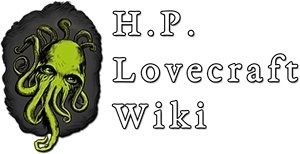![]()
![]()
![]() Satyrs are imaginary creatures from Greek mythology, often depicted as having the upper half of a man and the lower half of a goat. Though creatures resembling them have frequently been incorporated into Cthulhu Mythos fiction, they aren't actual Satyrs in the sense of the Greek legends, but rather beings related somehow to Lovecraftian origins.
Satyrs are imaginary creatures from Greek mythology, often depicted as having the upper half of a man and the lower half of a goat. Though creatures resembling them have frequently been incorporated into Cthulhu Mythos fiction, they aren't actual Satyrs in the sense of the Greek legends, but rather beings related somehow to Lovecraftian origins.
In Lovecraft's Fiction[]
In the story "The Horror at Red Hook", H. P. Lovecraft describes a parade of horrific creatures led by Lilith in the catacombs below Red Hook, which includes "goat, satyr, and aegipan, incubus, succuba, and lemur, twisted toad and shapeless elemental, dog-faced howler and silent strutter in darkness".
In Lovecraft's "The Nameless City", the narrator's sight of the city's inhabitants evokes "comparisons as varied as the cat, the bulldog, the mythic Satyr, and the human being".
In his "The Music of Erich Zann", listening to the music of Zann--who is twice described as "satyr-like"--the narrator "could almost see shadowy satyrs and Bacchanals dancing and whirling insanely through seething abysses of clouds".
In The Whisperer in Darkness, Albert Wilmarth initially compares the legend of winged crustacean creatures of the Vermont woods to similar legends about Satyrs, Fauns and Dryads from around the world.
Though Wilbur Whateley in "The Dunwich Horror" is not explicitly called a satyr, he is frequently described as "goatish", and after his death it is revealed that below his waist, his "skin was thickly covered with coarse black fur."
In The Dream-Quest of Unknown Kadath, Lovecraft depicts the Men of Leng as satyr-like humanoids with horns and hoofs.
Other Writers[]
Satyrs are said to inhabit the French province of Averoigne (CIRCLE: "The Satyr", Clark Ashton Smith) and at least some of them are known to be servants of Sheila-Na-Gog, a possible avatar or alias for Shub-Niggurath (EXP: "The Wedding of Sheila-Na-Gog", Glenn Rahman & R. L. Tierney). It's also been suggested that stories about satyrs might have been inspired by the Gof'nn hupadgh Shub-Niggurath (EXP: "The Moon-Lens", Ramsey Campbell).
A passage from the Necronomicon claims that when the time comes, the Spawn of Shub-Niggurath will "take dominion over all wood nymphs, satyrs, leprechauns, and the Little People". (AWD: "The House on Curwen Street", "The Keeper of the Key")
While hiding from the Hounds of Tindalos, Halpin Chalmers worried that his defenses against them might be insufficient if another race such as the Doels or the Satyrs help them break through. He notes that the Satyrs can "advance through the scarlet circles" and that the Greeks knew how to prevent that, but the knowledge has long been lost. (CIRCLE: "The Hounds of Tindalos")
Satyrs figure among the inhabitants of other dimensions that the sculptor Cyprian Sincaul has been in contact with and used as inspirations for his sculptures. (CIRCLE: "The Hunters from Beyond")
Norman Withers encountered a satyr when searching for his missing friend Claus Schmidt in Tindalos (EXP: Ire of the Void, Richard Lee Byers).
In F. C. Adams' "The Punishment of Igharta" (EXP), satyrs are the descendants of the titular Igharta, himself a product of the union between Shub-Niggurath and a human female.
